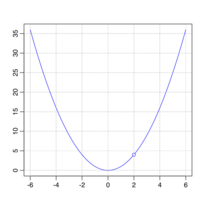Removable singularity
In complex analysis, a removable singularity of a holomorphic function is a point at which the function is undefined, but it is possible to redefine the function at that point in such a way that the resulting function is regular in a neighbourhood of that point.
For instance, the (unnormalized) sinc function, as defined by
- [math]\displaystyle{ \text{sinc}(z) = \frac{\sin z}{z} }[/math]
has a singularity at z = 0. This singularity can be removed by defining [math]\displaystyle{ \text{sinc}(0) := 1, }[/math] which is the limit of sinc as z tends to 0. The resulting function is holomorphic. In this case the problem was caused by sinc being given an indeterminate form. Taking a power series expansion for [math]\displaystyle{ \frac{\sin(z)}{z} }[/math] around the singular point shows that
- [math]\displaystyle{ \text{sinc}(z) = \frac{1}{z}\left(\sum_{k=0}^{\infty} \frac{(-1)^kz^{2k+1}}{(2k+1)!} \right) = \sum_{k=0}^{\infty} \frac{(-1)^kz^{2k}}{(2k+1)!} = 1 - \frac{z^2}{3!} + \frac{z^4}{5!} - \frac{z^6}{7!} + \cdots. }[/math]
Formally, if [math]\displaystyle{ U \subset \mathbb C }[/math] is an open subset of the complex plane [math]\displaystyle{ \mathbb C }[/math], [math]\displaystyle{ a \in U }[/math] a point of [math]\displaystyle{ U }[/math], and [math]\displaystyle{ f: U\setminus \{a\} \rightarrow \mathbb C }[/math] is a holomorphic function, then [math]\displaystyle{ a }[/math] is called a removable singularity for [math]\displaystyle{ f }[/math] if there exists a holomorphic function [math]\displaystyle{ g: U \rightarrow \mathbb C }[/math] which coincides with [math]\displaystyle{ f }[/math] on [math]\displaystyle{ U\setminus \{a\} }[/math]. We say [math]\displaystyle{ f }[/math] is holomorphically extendable over [math]\displaystyle{ U }[/math] if such a [math]\displaystyle{ g }[/math] exists.
Riemann's theorem
Riemann's theorem on removable singularities is as follows:
Theorem — Let [math]\displaystyle{ D \subset \mathbb C }[/math] be an open subset of the complex plane, [math]\displaystyle{ a \in D }[/math] a point of [math]\displaystyle{ D }[/math] and [math]\displaystyle{ f }[/math] a holomorphic function defined on the set [math]\displaystyle{ D \setminus \{a\} }[/math]. The following are equivalent:
- [math]\displaystyle{ f }[/math] is holomorphically extendable over [math]\displaystyle{ a }[/math].
- [math]\displaystyle{ f }[/math] is continuously extendable over [math]\displaystyle{ a }[/math].
- There exists a neighborhood of [math]\displaystyle{ a }[/math] on which [math]\displaystyle{ f }[/math] is bounded.
- [math]\displaystyle{ \lim_{z\to a}(z - a) f(z) = 0 }[/math].
The implications 1 ⇒ 2 ⇒ 3 ⇒ 4 are trivial. To prove 4 ⇒ 1, we first recall that the holomorphy of a function at [math]\displaystyle{ a }[/math] is equivalent to it being analytic at [math]\displaystyle{ a }[/math] (proof), i.e. having a power series representation. Define
- [math]\displaystyle{ h(z) = \begin{cases} (z - a)^2 f(z) & z \ne a ,\\ 0 & z = a . \end{cases} }[/math]
Clearly, h is holomorphic on [math]\displaystyle{ D \setminus \{a\} }[/math], and there exists
- [math]\displaystyle{ h'(a)=\lim_{z\to a}\frac{(z - a)^2f(z)-0}{z-a}=\lim_{z\to a}(z - a) f(z)=0 }[/math]
by 4, hence h is holomorphic on D and has a Taylor series about a:
- [math]\displaystyle{ h(z) = c_0 + c_1(z-a) + c_2 (z - a)^2 + c_3 (z - a)^3 + \cdots \, . }[/math]
We have c0 = h(a) = 0 and c1 = h'(a) = 0; therefore
- [math]\displaystyle{ h(z) = c_2 (z - a)^2 + c_3 (z - a)^3 + \cdots \, . }[/math]
Hence, where [math]\displaystyle{ z \ne a }[/math], we have:
- [math]\displaystyle{ f(z) = \frac{h(z)}{(z - a)^2} = c_2 + c_3 (z - a) + \cdots \, . }[/math]
However,
- [math]\displaystyle{ g(z) = c_2 + c_3 (z - a) + \cdots \, . }[/math]
is holomorphic on D, thus an extension of [math]\displaystyle{ f }[/math].
Other kinds of singularities
Unlike functions of a real variable, holomorphic functions are sufficiently rigid that their isolated singularities can be completely classified. A holomorphic function's singularity is either not really a singularity at all, i.e. a removable singularity, or one of the following two types:
- In light of Riemann's theorem, given a non-removable singularity, one might ask whether there exists a natural number [math]\displaystyle{ m }[/math] such that [math]\displaystyle{ \lim_{z \rightarrow a}(z-a)^{m+1}f(z)=0 }[/math]. If so, [math]\displaystyle{ a }[/math] is called a pole of [math]\displaystyle{ f }[/math] and the smallest such [math]\displaystyle{ m }[/math] is the order of [math]\displaystyle{ a }[/math]. So removable singularities are precisely the poles of order 0. A holomorphic function blows up uniformly near its other poles.
- If an isolated singularity [math]\displaystyle{ a }[/math] of [math]\displaystyle{ f }[/math] is neither removable nor a pole, it is called an essential singularity. The Great Picard Theorem shows that such an [math]\displaystyle{ f }[/math] maps every punctured open neighborhood [math]\displaystyle{ U \setminus \{a\} }[/math] to the entire complex plane, with the possible exception of at most one point.
See also
- Analytic capacity
- Removable discontinuity
External links
 |


